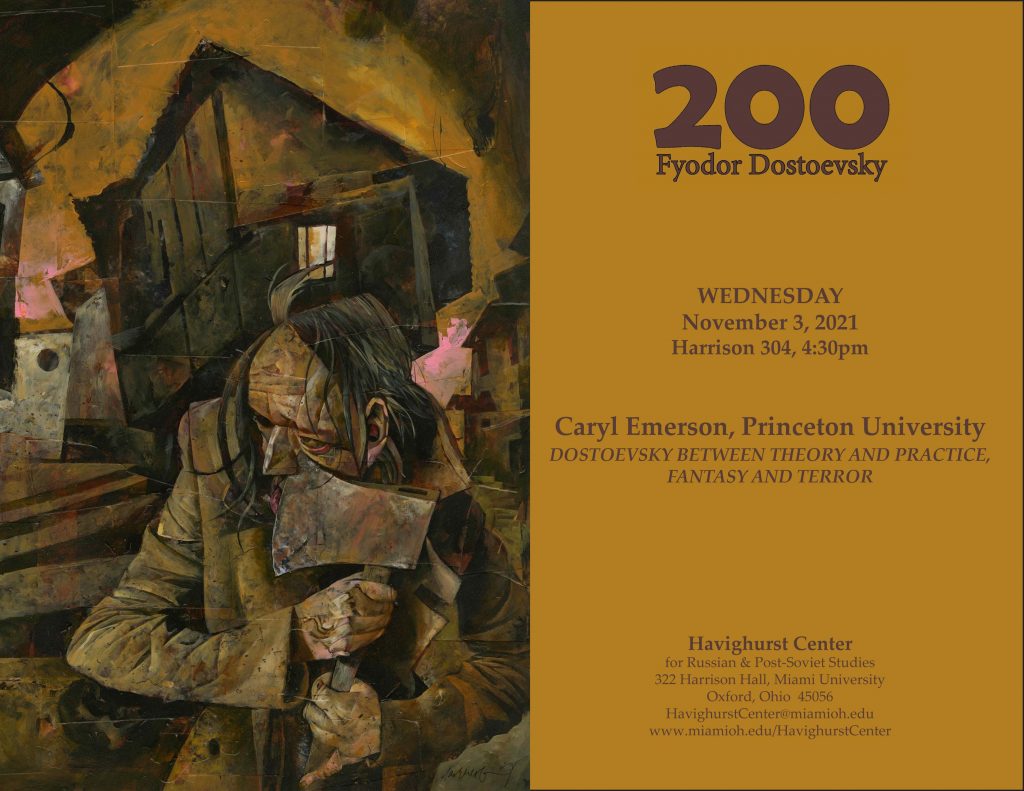By Joseph Sweetser-Puckett
Dr. Caryl Emerson, Armour Professor Emeritus of Slavic Languages and Literatures at Princeton University, visited Miami University on Wednesday, November 3, for a lecture synthesizing her half-century of work on Mikhail Bakhtin and Fyodor Dostoevsky. Over the course of her career Emerson has established herself as one of the nation’s most significant Dostoevsky scholars. Her lecture was the fourth in this year’s Havighurst Center Colloquium, which is focused on the works of Fyodor Dostoevsky in honor of the iconic Russian writer’s 200th birthday. Her lecture, on “Dostoevsky between Theory and Practice, Fantasy and Terror,” was a symphonic review of the present field of Dostoevsky scholarship, the beating heart of Dostoevsky’s work, and the great chasm in modern minds between the metaphysical and the material.
The metaphysical… What is God, anyways? What does a believer imagine at the mention of God?
“Dostoevsky between X and Y does not provide much of a roadmap,” Emerson stated early on. His writings have influenced psychology, philosophy, political science, linguistics, and history. Emerson’s stated goal was to break down the artificial divide between secular and religious interpretations of Dostoevsky’s works and shed light on why he has continued to spark conversations in psychology, philosophy, political science, sociology, and linguistics.
“What does it mean to apply Dostoevsky to our lives?” Emerson asked. “Must one be a believer to appreciate the thought patterns of one who is?” Dostoevsky dissuades us that faith protects the believer from error or accountability.
Are we bound to have faith in a higher power simply because we can imagine one? Is there a vacuum in our high imagination that, simply because of physics, fills with inferences from our perception below? What is filling mine?
The theories of Bakhtin exposed Dostoevsky’s techniques- that no utterance ever stands alone and is complete only with a response. The author incarnates alongside his characters. An internal dialogic struggle plays out which can never be finalized. Dostoevsky reaches for coexistence and interaction, for synthesis of his characters’ ways and language. The Orthodox belief that there is no void, that even when you cannot see or feel the Other, the Other is feeling your presence. It is good or bad news depending on what you are hiding. Critics of Bakhtin say walking into a novel and expecting a conversation, expecting to be heard, is absurd. That it’s asking too much to recuperate the experiences of another time.
These critics are becoming more correct as time passes and humanity cedes cognition to technical environments. They say artificial intelligence is rising. What quality separates human cognition from artificial intelligence? Can a machine become a human? Are we just machines, programmed by our impressions and automatic responses to them?
Emerson frankly addressed Dostoevsky’s political legacy- the terrible words he uttered into the Russian public sphere. His history of verbal provocation is not contained to Russian nationalist rhetoric. Verbal provocation is also central to his characters and plots. Even the Christ-like characters of Zosima and Myshkin provoke — either in soothing a raver into peace or in cutting through appearances with innocent intuition. Dostoevsky shows us how terror — the realm of terrorists — cannot always be talked through. Engaging directly with his inflammatory remarks, Emerson pointed to the reality of a man who was a severe trauma victim and addict, whose Other-worldly openness to the language and ways of his society didn’t always produce desirable results.
More important than the exposure of any outward terrorist is the terrorist within us. Our inner torment, the inner provoker, calling us to our obligation to mankind. The causes of our pain are obscure. Healing is possible, but painful and confusing. In Dostoevsky’s writings, the adults paint themselves with lies and explode into manic bursts of confession. They are so terrified of themselves that they constantly outsource themselves to others. As God became humanized in humanity’s imagination, it became easier to reject the overburdened tradition. To refute a pie-in-the-sky image of God is easy. What cannot be refuted, says Emerson, is the God of depth, of inner presence. The unmonitored and unending energies we cannot escape nor ignore.
What does it mean to be self-centered? Is it true that we’re more self-centered now than we used to be? I remember my grandparents saying the same thing about every generation of people. There’s a correlation in those geezers, somehow everyone gets more and more self-centered as they grow older and greyer… Or what if they’re right? What if we’ve steadily been getting worse for that long?
“Dostoevsky’s novels are allegories, designed to jolt us into a new way of thinking about ultimate reality, they should not be judged by such sentimental criteria such as happiness, success or even justice,” Emerson shared from one scholar. So she and a lifetime of experience have convinced me that Dostoevsky created a new physical and moral reality, a new relationship between art and knowledge. “Until you choose something it’s not part of you,” said Emerson. “You’re still a human being. Until you decide to care about it and decide to increase your own agency by means of it, theory is make-believe.”
Joseph Sweetser-Puckett is a junior studying English literature and history. He is revising his debut novel, The Automan.

